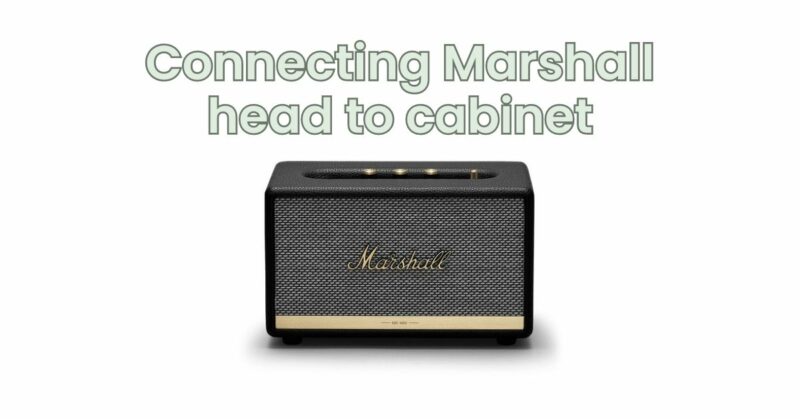Marshall amplifiers have long been revered for their iconic rock and roll tone, and connecting a Marshall amplifier head to a matching speaker cabinet is a classic setup for guitarists looking to unleash their sonic potential. In this article, we will guide you through the process of connecting a Marshall amplifier head to a speaker cabinet, discussing the necessary connections, considerations, and best practices for achieving optimal sound and performance.
Understanding Marshall Amplifier Heads and Speaker Cabinets: Marshall amplifier heads are renowned for their powerful, high-gain sound and distinctive British tone. They are designed to be paired with Marshall speaker cabinets to deliver the full Marshall experience. Marshall speaker cabinets come in various configurations, featuring specially designed speakers that complement the amplifier’s characteristics.
- Impedance Matching: Impedance matching between the amplifier head and the speaker cabinet is crucial to ensure proper power distribution and prevent damage to your equipment. Marshall amplifiers typically have selectable impedance settings, such as 4, 8, or 16 ohms, to match different speaker cabinet configurations.
- Speaker Cable Selection: Using high-quality speaker cables is essential for maintaining signal integrity and preventing unwanted noise or signal loss. Ensure that the speaker cable you choose has the appropriate connectors for both the amplifier head and the speaker cabinet.
Connecting a Marshall Head to a Speaker Cabinet: Step-by-Step Guide:
- Power Off and Unplug: Before making any connections, turn off the amplifier head and unplug it from the power source. This precaution ensures safety during the setup process.
- Verify Impedance Compatibility: Check the impedance rating of your speaker cabinet and select the appropriate impedance setting on your Marshall amplifier head. The impedance ratings should match or be compatible to ensure proper power distribution.
- Locate Speaker Outputs: Identify the speaker output jacks on your Marshall amplifier head. These are usually located on the rear panel and labeled accordingly.
- Connect the Speaker Cable: Take one end of the speaker cable and plug it into the appropriate speaker output jack on your amplifier head. Ensure a secure connection by firmly pushing the connector into the jack.
- Connect to the Speaker Cabinet: Take the other end of the speaker cable and connect it to the input jack on the speaker cabinet. Ensure a secure connection, making sure the connector is fully inserted into the jack.
- Double-Check Connections: Verify that all connections are secure and properly made. Loose or faulty connections can result in poor sound quality or intermittent signal loss.
- Power On and Test: Power on your Marshall amplifier head and gradually increase the volume to test the sound output. Monitor for any unusual noises, pops, or distortion. Adjust the settings as needed to achieve your desired sound.
Considerations and Best Practices:
- Impedance Matching: Ensure that the impedance settings on both the amplifier head and the speaker cabinet are properly matched. Mismatched impedance can result in improper power distribution, reduced sound quality, or even damage to your amplifier or speakers.
- Power Handling: Check the power handling capabilities of your speaker cabinet to ensure it can handle the power output of your Marshall amplifier head. Exceeding the power rating of the cabinet can damage the speakers or compromise their performance.
- Manufacturer Guidelines: Consult the manufacturer’s documentation or online resources for specific recommendations and guidelines regarding connecting a Marshall amplifier head to a speaker cabinet. Marshall provides detailed information on impedance options and speaker cabinet compatibility for their products.
- Experiment and Fine-Tuning: Once connected, take the time to experiment with different settings on your Marshall amplifier head and speaker cabinet to find the best tone for your playing style and musical preferences. Adjust the EQ, gain, and other controls to shape your desired sound.
Conclusion: Connecting a Marshall amplifier head to a speaker cabinet is a thrilling step toward unleashing the iconic Marshall tone. By following the steps outlined in this article and considering the important considerations and best practices, you can create a powerful and immersive sonic experience. Ensure proper impedance matching, use high-quality speaker cables, and consult manufacturer guidelines for your specific Marshall amplifier head and speaker cabinet. With your Marshall rig properly connected, you can immerse yourself in the legendary sound that has defined countless rock and roll moments, and embark on your own musical journey with confidence and sonic excellence.

